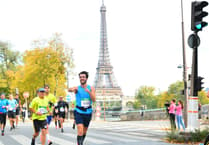BACK during the 1940s when I attended Landrake School, we would all pick hazel nuts to eat.
I can remember four of us boys would spend the latter part of the summer holiday walking around fields near the village picking up pockets full of these nuts.
We would then settle down in a gateway or on a grassy bank with two stones on our laps. We placed a nut on the larger stone, then cracked it open with the smaller one and then ate the kernel.
The more serious nut-picking walks were with our mother, who kept a special ‘nut picking’ stick with a hooked end with which she pulled the branches down for easier picking.
However, mother insisted that all the nuts that we collected were ‘slipshell’ – ones that left their husks easily – so were fully ripe.
All that we collected were put into a small hessian bag which was hooked on a cruck on the kitchen ceiling near the black stove where they were dried and kept until Christmas Day.
Mother would also buy a coconut down in the village Co-op and we all shared this nut as well.
Father worked on a farm and with six children, money could not be spent on luxuries, so we had roast chicken for Christmas lunch.
If you go collecting hazels in the countryside, you have to compete with squirrels that eat them ‘on the hoof’ but bury most of the ones they find.
Squirrels must have great brains if they can remember where they bury what is intended as their winter food.
I pick up a few hazels and leave them in the garden for squirrels, but I think most of these nuts are buried as we find small hazel trees coming up all over the garden.
It seems that this year all the oak trees in the parish have galls on them.
Knopper galls grow right beside the acorns on the Pedunculate or English oaks and are caused by the larvae of the tiny wasp Andricus quercuscalicis which lays her eggs, using a sharp ovipositor, into the bud of the acorn.
The resultant larvae eat the ‘flesh’ of the gall as both get bigger until the wasp has formed and escapes through a hole in the gall.
There are still lots of Hogweed plants out in bloom around the village with their large umbels of off-white flowers that are a platform for many insects to feed on.
I have noticed that on many plants their leaves are covered with white lines, and these are caused by the Hogweed leaf miner laying its eggs on them.
The resulting larvae hatch inside the leaves and eat the flesh of the leaves as they develop, causing white markings as they travel throughout the foliage.
A visitor to our garden was a Southern Hawker dragonfly which my wife photographed resting on the fence beside the pond.
I hope it was a female hawker and laid some eggs before flying away.
Black Nightshade with its small star-shaped white flowers grows on cultivated ground and is usually seen around the edge of arable fields and in gardens.
I found one out in bloom beside the garden fence and, as they are poisonous, children and dogs should be kept away from them.




